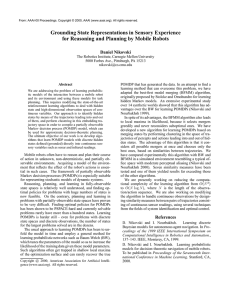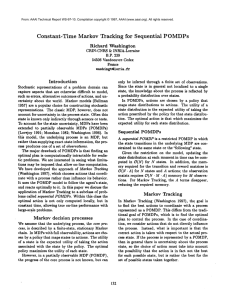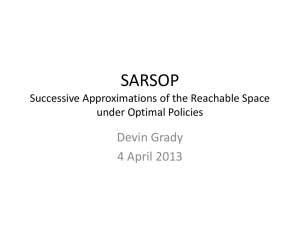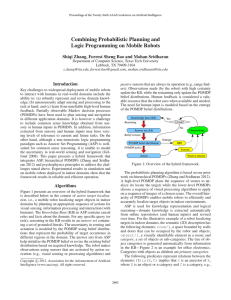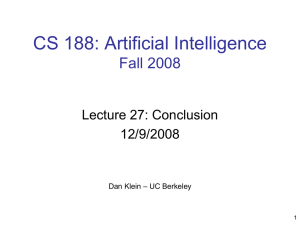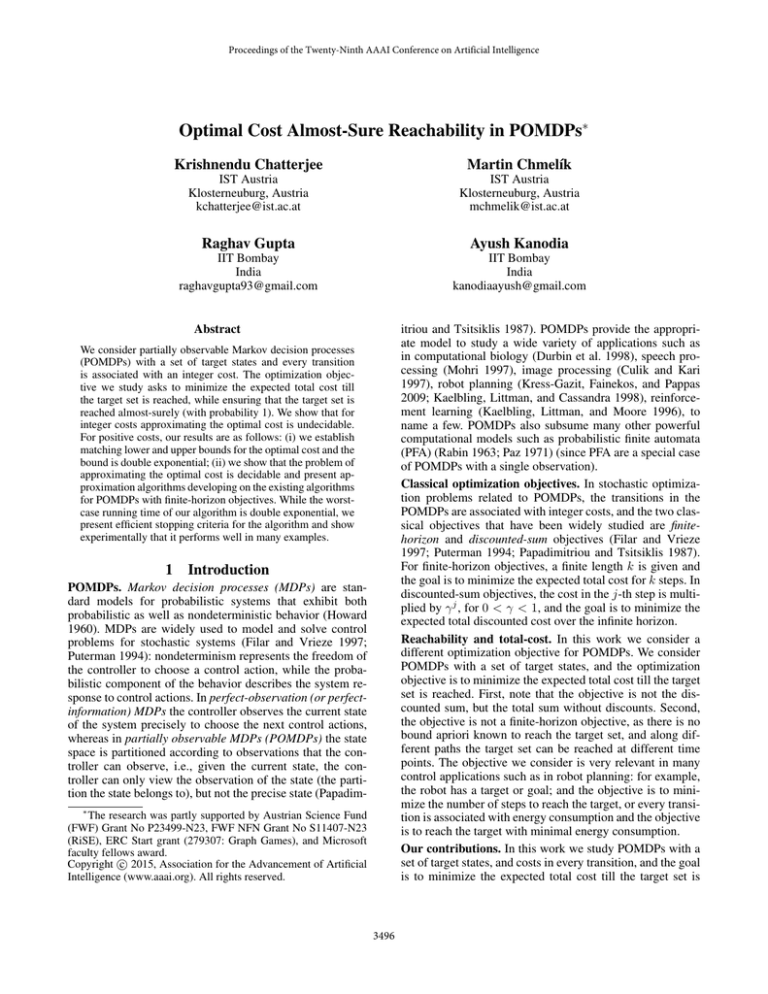
Proceedings of the Twenty-Ninth AAAI Conference on Artificial Intelligence
Optimal Cost Almost-Sure Reachability in POMDPs∗
Krishnendu Chatterjee
Martin Chmelı́k
IST Austria
Klosterneuburg, Austria
kchatterjee@ist.ac.at
IST Austria
Klosterneuburg, Austria
mchmelik@ist.ac.at
Raghav Gupta
Ayush Kanodia
IIT Bombay
India
raghavgupta93@gmail.com
IIT Bombay
India
kanodiaayush@gmail.com
Abstract
itriou and Tsitsiklis 1987). POMDPs provide the appropriate model to study a wide variety of applications such as
in computational biology (Durbin et al. 1998), speech processing (Mohri 1997), image processing (Culik and Kari
1997), robot planning (Kress-Gazit, Fainekos, and Pappas
2009; Kaelbling, Littman, and Cassandra 1998), reinforcement learning (Kaelbling, Littman, and Moore 1996), to
name a few. POMDPs also subsume many other powerful
computational models such as probabilistic finite automata
(PFA) (Rabin 1963; Paz 1971) (since PFA are a special case
of POMDPs with a single observation).
Classical optimization objectives. In stochastic optimization problems related to POMDPs, the transitions in the
POMDPs are associated with integer costs, and the two classical objectives that have been widely studied are finitehorizon and discounted-sum objectives (Filar and Vrieze
1997; Puterman 1994; Papadimitriou and Tsitsiklis 1987).
For finite-horizon objectives, a finite length k is given and
the goal is to minimize the expected total cost for k steps. In
discounted-sum objectives, the cost in the j-th step is multiplied by γ j , for 0 < γ < 1, and the goal is to minimize the
expected total discounted cost over the infinite horizon.
Reachability and total-cost. In this work we consider a
different optimization objective for POMDPs. We consider
POMDPs with a set of target states, and the optimization
objective is to minimize the expected total cost till the target
set is reached. First, note that the objective is not the discounted sum, but the total sum without discounts. Second,
the objective is not a finite-horizon objective, as there is no
bound apriori known to reach the target set, and along different paths the target set can be reached at different time
points. The objective we consider is very relevant in many
control applications such as in robot planning: for example,
the robot has a target or goal; and the objective is to minimize the number of steps to reach the target, or every transition is associated with energy consumption and the objective
is to reach the target with minimal energy consumption.
Our contributions. In this work we study POMDPs with a
set of target states, and costs in every transition, and the goal
is to minimize the expected total cost till the target set is
We consider partially observable Markov decision processes
(POMDPs) with a set of target states and every transition
is associated with an integer cost. The optimization objective we study asks to minimize the expected total cost till
the target set is reached, while ensuring that the target set is
reached almost-surely (with probability 1). We show that for
integer costs approximating the optimal cost is undecidable.
For positive costs, our results are as follows: (i) we establish
matching lower and upper bounds for the optimal cost and the
bound is double exponential; (ii) we show that the problem of
approximating the optimal cost is decidable and present approximation algorithms developing on the existing algorithms
for POMDPs with finite-horizon objectives. While the worstcase running time of our algorithm is double exponential, we
present efficient stopping criteria for the algorithm and show
experimentally that it performs well in many examples.
1
Introduction
POMDPs. Markov decision processes (MDPs) are standard models for probabilistic systems that exhibit both
probabilistic as well as nondeterministic behavior (Howard
1960). MDPs are widely used to model and solve control
problems for stochastic systems (Filar and Vrieze 1997;
Puterman 1994): nondeterminism represents the freedom of
the controller to choose a control action, while the probabilistic component of the behavior describes the system response to control actions. In perfect-observation (or perfectinformation) MDPs the controller observes the current state
of the system precisely to choose the next control actions,
whereas in partially observable MDPs (POMDPs) the state
space is partitioned according to observations that the controller can observe, i.e., given the current state, the controller can only view the observation of the state (the partition the state belongs to), but not the precise state (Papadim∗
The research was partly supported by Austrian Science Fund
(FWF) Grant No P23499-N23, FWF NFN Grant No S11407-N23
(RiSE), ERC Start grant (279307: Graph Games), and Microsoft
faculty fellows award.
c 2015, Association for the Advancement of Artificial
Copyright Intelligence (www.aaai.org). All rights reserved.
3496
(v) O : S → Z is an observation function that maps every state to an observation. For simplicity of presentation we
consider without loss of generality a deterministic function,
see Remark 1 in (Chatterjee et al. 2014) for probabilistic observations; and (vi) λ0 is a probability distribution for the
initial state, and for all s, s0 ∈ Supp(λ0 ) we require that
O(s) = O(s0 ). If the initial distribution is Dirac, we often write λ0 as s0 where s0 is the unique starting (or initial)
state. Given s, s0 ∈ S and a ∈ A, we also write δ(s0 |s, a) for
δ(s, a)(s0 ). A state s is absorbing if for all actions a we have
δ(s, a)(s) = 1 (i.e., s is never left from s). For an observation z, we denote by O−1 (z) = {s ∈ S | O(s) = z} the set
of states with observation z. For a set U ⊆ S of states and
Z ⊆ Z of observations we denote
S O(U ) = {z ∈ Z | ∃s ∈
U. O(s) = z} and O−1 (Z) = z∈Z O−1 (z). A POMDP is
a perfect-observation (or perfect-information) MDP if each
state has a unique observation.
reached, while ensuring that the target set is reached almostsurely (probability 1). Our results are as follows:
1. (Integer costs). We first show that if the costs are integers,
then approximating the optimal cost is undecidable.
2. (Positive integer costs). Since the problem is undecidable
for integer costs, we next consider that costs are positive
integers. We first remark that if the costs are positive, and
there is a positive probability not to reach the target set,
then the expected total cost is infinite. Hence the expected
total cost is not infinite only by ensuring that the target is reached almost-surely. First we establish a doubleexponential lower and upper bound for the expected optimal cost. We show that the approximation problem is decidable, and present approximation algorithms using the
well-known algorithms for finite-horizon objectives.
3. (Implementation). Though we establish that in the worstcase the algorithm requires double-exponential time, we
also present efficient stopping criteria for the algorithm,
and experimentally show that the algorithm is efficient in
several practical examples. We have implemented our approximation algorithms developing on the existing implementations for finite-horizon objectives, and present experimental results on a number of well-known examples.
Plays, cones, and belief-supports. A play (or a path) in a
POMDP is an infinite sequence (s0 , a0 , s1 , a1 , s2 , a2 , . . .)
of states and actions such that for all i ≥ 0 we have
δ(si , ai )(si+1 ) > 0 and s0 ∈ Supp(λ0 ). We write Ω for
the set of all plays. For a finite prefix w ∈ (S · A)∗ · S
of a play, we denote by Cone(w) the set of plays with w
as the prefix (i.e., the cone or cylinder of the prefix w),
and denote by Last(w) the last state of w. For a finite prefix w = (s0 , a0 , s1 , a1 , . . . , sn ) we denote by O(w) =
(O(s0 ), a0 , O(s1 ), a1 , . . . , O(sn )) the observation and action sequence associated with w. For a finite sequence
ρ = (z0 , a0 , z1 , a1 , . . . , zn ) of observations and actions, the
belief-support B(ρ) after the prefix ρ is the set of states in
which a finite prefix of a play can be after the sequence ρ
of observations and actions, i.e., B(ρ) = {sn = Last(w) |
w = (s0 , a0 , s1 , a1 , . . . , sn ), w is a prefix of a play, and for
all 0 ≤ i ≤ n. O(si ) = zi }.
Comparison with Goal-POMDPs. While there are several works for discounted POMDPs (Kurniawati, Hsu, and
Lee 2008; Smith and Simmons 2004; Pineau et al. 2003),
as mentioned above the problem we consider is different
from discounted POMDPs. The most closely related works
are Goal-MDPs and POMDPs (Bonet and Geffner 2009;
Kolobov et al. 2011). The key differences are as follows:
(a) our results for approximation apply to all POMDPs
with positive integer costs, whereas the solution for GoalPOMDPs applies to a strict subclass of POMDPs (see Remark 5 in (Chatterjee et al. 2014)); and (b) we present
asymptotically tight (double exponential) theoretical bounds
on the expected optimal costs. Full proofs are available
in (Chatterjee et al. 2014).
2
Strategies (or policies). A strategy (or a policy) is a recipe
to extend prefixes of plays and is a function σ : (S·A)∗ ·S →
D(A) that given a finite history (i.e., a finite prefix of a play)
selects a probability distribution over the actions. Since we
consider POMDPs, strategies are observation-based, i.e., for
all histories w = (s0 , a0 , s1 , a1 , . . . , an−1 , sn ) and w0 =
(s00 , a0 , s01 , a1 , . . . , an−1 , s0n ) such that for all 0 ≤ i ≤ n
we have O(si ) = O(s0i ) (i.e., O(w) = O(w0 )), we must
have σ(w) = σ(w0 ). In other words, if the observation sequence is the same, then the strategy cannot distinguish between the prefixes and must play the same. A strategy σ is
belief-support based stationary if it depends only on the current belief-support, i.e., whenever for two histories w and
w0 , we have B(O(w)) = B(O(w0 )), then σ(w) = σ(w0 ).
Definitions
We present the definitions of POMDPs, strategies, objectives, and other basic notions required for our results. Throughout this work, we follow standard notations
from (Puterman 1994; Littman 1996).
Notations. Given a finite set X, we denote by P(X) the
set of subsets of X, i.e., P(X) is the power set of X. A
probabilityP
distribution f on X is a function f : X → [0, 1]
such that x∈X f (x) = 1, and we denote by D(X) the
set of all probability distributions on X. For f ∈ D(X) we
denote by Supp(f ) = {x ∈ X | f (x) > 0} its support.
Probability and expectation measures. Given a strategy σ and a starting state s, the unique probability measure obtained given σ is denoted as Pσs (·). We first define the measure µσs (·) on cones. For w = s we have
µσs (Cone(w)) = 1, and for w = s0 where s 6= s0 we
have µσs (Cone(w)) = 0; and for w0 = w · a · s we have
µσs (Cone(w0 )) = µσs (Cone(w))·σ(w)(a)·δ(Last(w), a)(s).
By Carathéodory’s extension theorem, the function µσs (·)
can be uniquely extended to a probability measure Pσs (·)
over Borel sets of infinite plays (Billingsley 1995). We de-
POMDPs. A Partially Observable Markov Decision Process (POMDP) is a tuple G = (S, A, δ, Z, O, λ0 ) where:
(i) S is a finite set of states; (ii) A is a finite alphabet of
actions; (iii) δ : S × A → D(S) is a probabilistic transition function that given a state s and an action a ∈ A
gives the probability distribution over the successor states,
i.e., δ(s, a)(s0 ) denotes the transition probability from s to
s0 given action a; (iv) Z is a finite set of observations;
3497
note by Eσs [·] the expectation measure associated with the
σ
strategy
σ. For an initial distribution
P
P λ0 we have σPλ0 (·) =
σ
σ
s∈S λ0 (s) · Ps (·) and Eλ0 [·] =
s∈S λ0 (s) · Es [·].
Objectives. We consider the following objectives.
• Reachability objectives. A reachability objective in a
POMDP G is a measurable set ϕ ⊆ Ω of plays
and is defined as follows: given a set T ⊆ S of
target states, the reachability objective Reach(T ) =
{(s0 , a0 , s1 , a1 , s2 . . .) ∈ Ω | ∃i ≥ 0 : si ∈ T } requires
that a target state in T is visited at least once.
• Total-cost and finite-length total-cost objectives. A totalcost objective is defined as follows: Let G be a POMDP
with a set of absorbing target states T and a cost function
c : S × A → Z that assigns integer-valued weights to
all states and actions such that for all states t ∈ T and
all actions a ∈ A we have c(t, a) = 0. The total-cost
of a play ρ = (s0 , a0 , s1 , a1 , s2 , a2 , . . .) is Total(ρ) =
P
∞
i=0 c(si , ai ) the sum of the costs of the play. To analyze total-cost objectives we will also require finite-length
total-cost objectives, that for a given length k sum the toPk
tal costs upto length k; i.e., Totalk (ρ) = i=0 c(si , ai ).
Almost-sure winning. Given a POMDP G with a reachability objective Reach(T ) a strategy σ is almost-sure winning
iff Pσλ0 (Reach(T )) = 1. We will denote by AlmostG (T ) the
set of almost-sure winning strategies in POMDP G for the
objective Reach(T ). Given a set U such that all states in U
have the same observation, a strategy is almost-sure winning
from U , if given the uniform probability distribution λU over
U we have PσλU (Reach(T )) = 1; i.e., the strategy ensures
almost-sure winning if the starting belief-support is U .
Optimal cost under almost-sure winning and approximations. Given a POMDP G with a reachability objective Reach(T ) and a cost function c we are interested in
minimizing the expected total cost before reaching the target set T , while ensuring that the target set is reached
almost-surely. Formally, the value of an almost-sure winning strategy σ ∈ AlmostG (T ) is the expectation Val(σ) =
Eσλ0 [Total]. The optimal cost is defined as the infimum of
expected costs among all almost-sure winning strategies:
optCost = inf σ∈AlmostG (T ) Val(σ). We consider the computational problems of approximating optCost and compute
strategies σ ∈ AlmostG (T ) such that the value Val(σ) approximates the optimal cost optCost. Formally, given > 0,
the additive approximation problem asks to compute a strategy σ ∈ AlmostG (T ) such that Val(σ) ≤ optCost + ; and
the multiplicative approximation asks to compute a strategy
σ ∈ AlmostG (T ) such that Val(σ) ≤ optCost · (1 + ).
3
finitely many steps, and has a set F of desired final states.
The strict emptiness problem asks for the existence of a strategy w (a finite word over the alphabet A) such that the measure of the runs ending in the desired final states F is strictly
greater than 21 ; and the problem is undecidable (Paz 1971).
Reduction. Given a PFA P = (S, A, δ, F, s0 ) we construct
a POMDP G = (S 0 , A0 , δ 0 , Z, O, s00 ) with a cost function
c and a target set T such that there exists a word w ∈ A∗
accepted with probability strictly greater than 12 in PFA P
iff the optimal cost in the POMDP G is −∞. Intuitively, the
construction of the POMDP G is as follows: for every state
s ∈ S of P we construct a pair of states (s, 1) and (s, −1) in
S 0 with the property that (s, −1) can only be reached with
a new action $ (not in A) played in state (s, 1). The transition function δ 0 from the state (s, −1) mimics the transition function δ, i.e., δ 0 ((s, −1), a)((s0 , 1)) = δ(s, a)(s0 ).
The cost c of (s, 1) (resp. (s, −1)) is 1 (resp. −1), ensuring
the sum of the pair to be 0. We add a new available action #
that when played in a final state reaches a newly added state
good ∈ S 0 , and when played in a non-final state reaches a
newly added state bad ∈ S 0 . For states good and bad given
action # the next state is the initial state; with negative cost
−1 for good and positive cost 1 for bad. We introduce a single absorbing target state T = {target} and give full power
to the player to decide when to reach the target
√ state from
the initial state, i.e., we introduce a new action that when
played in the initial state deterministically reaches the target
state target. Whenever an action is played in a state where
it is not available, the POMDP reaches a losing absorbing
state, i.e., an absorbing state with cost 1 on all actions. We
show that if the answer to the strict emptiness problem is yes,
then the optimal cost is −∞, and conversely, if the answer
is no, then the optimal cost is 1.
Theorem 1. The problem of approximating the optimal cost
in POMDPs with integer costs is undecidable for all > 0
both for additive and multiplicative approximation.
4
Approximation for Positive Costs
In this section we consider positive cost functions, i.e., c :
S × A → N instead of c : S × A → Z. Note that the transitions from the absorbing target states have cost 0 as the goal
is to minimize the cost till the target set is reached. Theorem 1 established undecidability for integer costs, and we
now show that for positive cost functions the approximation
problem is decidable.
4.1
Lower Bound on optCost
We present a double-exponential lower bound on optCost
with respect to the number of states of the POMDP. We define a family of POMDPs F(n), for every n, with a single
target state, such that there exists an almost-sure winning
strategy, and for every almost-sure winning strategy the expected number of steps to reach the target state is doubleexponential in the number of states of the POMDP. Assigning cost 1 to every transition we get the lower bound.
Preliminary. The action set we consider consists of two
symbols A = {a, #}. The state space consists of an initial state s0 , a target state target, a losing absorbing state
Approximation for Integer Costs
In this section we will show that the problem of approximating the optimal cost optCost is undecidable. We will show
that deciding whether the optimal cost optCost is −∞ or not
is undecidable in POMDPs with integer costs. We present a
reduction from the standard undecidable problem for probabilistic finite automata (PFA). A PFA P = (S, A, δ, F, s0 )
is a special case of a POMDP G = (S, A, δ, Z, O, s0 ) with
a single observation Z = {z} such that for all states s ∈ S
we have O(s) = z. Moreover, the PFA proceeds for only
3498
bad and a set of n sub-POMDPs Li for 1 ≤ i ≤ n. Every sub-POMDP Li consists of states Qi that form a loop of
i
, where p(i) denotes the i-th prime
p(i) states q1i , q2i , . . . qp(i)
i
number and q1 is the initial state of the sub-POMDP. For every state qji (for 1 ≤ j ≤ p(i)) the transition function under
i
action a moves the POMDP to the state q(j
mod p(i))+1 with
1
probability 2 and to the initial state s0 with the remaining
i
probability 12 . The action # played in the state qp(i)
moves
the POMDP to the target state target with probability 12 and
to the initial state s0 with the remaining probability 12 . For
every other state in the loop qji such that 1 ≤ j < p(i) the
POMDP moves under action # to the losing absorbing state
bad with probability 1. The losing state bad and the target
state target are absorbing and have a self-loop under both
actions with probability 1.
POMDP family F(n). Given an n ∈ N we define the
POMDP F(n) as follows:
• The state space S = Q1 ∪ Q2 ∪ . . . Qn ∪ {s0 , bad, target}
with initial state s0 .
• There are two available actions A = {a, #}.
• The transition function is defined as follows: action a in
the initial state leads to bad with probability 1 and action
# in the initial state leads with probability n1 to the initial
state of the sub-POMDP Li for every 1 ≤ i ≤ n. The
transitions for the states in the sub-POMDPs are described
in the previous paragraph.
• All the states in the sub-POMDPs Li have observation z.
The remaining states s0 , bad, and target are visible.
The cost function c is as follows: the self-loop transitions
at target have cost 0 and all other transitions have cost 1.
An example of the construction for n = 2 is depicted in
Figure 1, where we omit the losing absorbing state bad and
the transitions to bad for simplicity.
Lemma 1. There exists a family (F(n))n∈N of POMDPs of
size O(p(n)) for a polynomial p with a reachability objective, such that there exists a polynomial q such that for every
almost-sure winning strategy the expected total cost to reach
q(n)
the target state is at least 22 .
4.2
s0
a, 12
a, 12
q11
a, 12
a, 12
q21
a, 21
#, 12
#, 21
q12
a, 12
#, 21
#, 21
a, 12
#, 21
a, #
T
a, 12
#, 12
q32
a, 12
a, 12
q22
Figure 1: POMDP F(2)
Belief updates. Given a belief U ∈ Belief(G), an action a ∈
A, and an observation z ∈ Z we denote by Update(U, z, a)
the updated belief. Formally, the setSUpdate(U, z, a) is defined as follows: Update(U, z, a) = s0 ∈U Supp(δ(s0 , a))∩
O−1 (z). The set of beliefs reachable from U by playing an action a ∈ A is denoted by Update(U, a). Formally, Update(U, a) = {U 0 ⊆ S | ∃z ∈ Z : U 0 =
Update(U, z, a)) ∧ U 0 6= ∅}.
Allowed actions. Given a POMDP G and a belief U ∈
Belief Win (G, T ), we consider the set of actions that are guaranteed to keep the next belief U 0 in Belief Win (G, T ) and refer these actions as allowed or safe. A framework that restricts playable actions was also considered in (Carvalho and
Teichteil-Königsbuch 2013), however, the allowed actions
need to be specified as a part of the input. In comparison we
show how to compute with respect to the reachability objective the set of allowed actions for the optimal reachability.
Formally we consider the set of allowed actions as follows:
Given a belief U ∈ Belief Win (G, T ) we define Allow(U ) =
{a ∈ A | ∀U 0 ∈ Update(U, a) : U 0 ∈ Belief Win (G, T )}.
We show that almost-sure winning strategies must only play
allowed actions. An easy consequence of the lemma is that
for all beliefs U in Belief Win (G, T ), there is always an allowed action. For an illustrative example see Example 1
in (Chatterjee et al. 2014).
Upper Bound on optCost
Almost-sure winning belief-supports. Let Belief(G) denote the set of all belief-supports in a POMDP G, i.e.,
Belief(G) = {U ⊆ S | ∃z ∈ Z : U ⊆ O−1 (z)}.
Since we will only consider belief-supports, for brevity
we call them beliefs in the sequel of this section. Let
Belief Win (G, T ) denote the set of almost-sure winning
beliefs, i.e., Belief Win (G, T ) = {U ∈ Belief(G) |
there exists an almost-sure winning strategy from U }, i.e.,
there exists an almost-sure winning strategy with initial uniform distribution λU over U .
Restricting to Belief Win (G, T ). In the sequel w.l.o.g. we
will restrict ourselves to beliefs in Belief Win (G, T ): since
from beliefs outside Belief Win (G, T ) there exists no almostsure winning strategy, all almost-sure winning strategies
with starting beliefs in Belief Win (G, T ) will ensure that beliefs not in Belief Win (G, T ) are never reached.
Lemma 2. Given a POMDP with a reachability objective Reach(T ), consider a strategy σ and a starting belief in Belief Win (G, T ). Given σ, if for a reachable belief
U ∈ Belief Win (G, T ) the strategy σ plays an action not in
Allow(U ) with positive probability, then σ is not almost-sure
winning for the reachability objective.
Corollary 1. For all U
Allow(U ) 6= ∅.
∈ Belief Win (G, T ) we have
The strategy σAllow . We consider a belief-based stationary
(for brevity belief-based) strategy σAllow as follows: for all
beliefs U in Belief Win (G, T ), the strategy plays uniformly at
random all actions from Allow(U ).
3499
min
Lemma 3. The belief-based strategy σAllow is an almostsure winning strategy for all beliefs U ∈ Belief Win (G, T )
for the objective Reach(T ).
a∈Allow(Supp(b))
We obtain a strategy σkFO that is finite-horizon optimal for
length k (here FO stands for finite-horizon optimal) from
the above equation. Given σkFO , we define a strategy σk∗ as
follows: for the first k steps, the strategy σk∗ plays as the
strategy σkFO , and after the first k steps the strategy plays as
the strategy σAllow .
Lemma 5. For all k ∈ N the strategy σk∗ is almost-sure
winning for the reachability objective Reach(T ).
Note that the only restriction in the construction of the
strategy σkFO is that it must play only allowed actions, and
since almost-sure winning strategies only play allowed actions (by Lemma 2) we have the following result. Note that
since in the first k steps σk∗ plays as σkFO we have Lemma 6
and Proposition 1.
Remark 1 (Computation of σAllow ). It follows from
Lemma 3 that the strategy σAllow can be computed by computing the set of almost-sure winning states in the belief
MDP. The belief MDP is a perfect-observation MDP where
states are beliefs of the original POMDP, and given an action, the next state is obtained according to the belief updates. The strategy σAllow can be obtained by computing the
set of almost-sure winning states in the belief MDP, and for
discrete graph algorithms to compute almost-sure winning
states in perfect-observation MDPs see (Courcoubetis and
Yannakakis 1995; Chatterjee and Henzinger 2011).
Upper bound. We now establish a double-exponential upper bound on optCost, matching our lower bound from
Lemma 1. We have that σAllow ∈ AlmostG (T ). Hence we
have Val(σAllow ) ≥ inf σ∈AlmostG (T ) Val(σ) = optCost.
Once σAllow is fixed, since the strategy is belief-based (i.e.,
depends on the subset of states) we obtain an exponential
size Markov chain. It follows that the expected hitting time
to the target set is at most double exponential.
Lemma 6. For all k
inf σ∈AlmostG (T ) Eσλ0 [Totalk ].
∈
σ∗
σ∗
N, Eλk0 [Totalk ]
=
σ FO
Proposition 1. For all k ∈ N, Eλk0 [Totalk ] = Eλk0 [Totalk ].
4.4
Approximation algorithm
We now show that for all > 0 there exists a bound k such
that the strategy σk∗ approximates optCost within . First we
consider an upper bound on optCost.
Bound UAllow . We consider an upper bound UAllow on the expected total cost of the strategy σAllow starting in an arbitrary
state s ∈ U with the initial belief U ∈ Belief Win (G, T ).
Given a belief U ∈ Belief Win (G, T ) and a state s ∈
U let TAllow (s, U ) denote the expected total cost of the
strategy σAllow starting in the state s with the initial belief U . Then the upper bound is defined as UAllow =
maxU ∈Belief Win (G,T ),s∈U TAllow (s, U ). As the strategy σAllow
is in AlmostG (T ), the value UAllow is also an upper bound
for the optimal cost optCost. By Lemma 4, UAllow is at most
double exponential in the size of the POMDP.
Lemma 7. We have optCost ≤ UAllow .
Let Ek denote the event of reaching the target set within k
steps, i.e., Ek = {(s0 , a0 , s1 , . . .) ∈ Ω | ∃i ≤ k : si ∈ T };
and E k the complement of the event Ek .
Lemma 8. For k ∈ N consider the strategy σk∗ that is obtained by playing an optimal finite-horizon strategy σkFO for
σ∗
k steps, followed by strategy σAllow . Let αk = Pλk0 (E k ) denote the probability that the target set is not reached within
σ∗
σ∗
the first k steps, then Eλk0 [Total] ≤ Eλk0 [Totalk ]+αk ·UAllow .
Lemma 9. For k ∈ N consider the strategy σk∗ and αk (as
defined in Lemma 8). The following assertions hold:
optCost
σ∗
(1) Eλk0 [Totalk ] ≤ optCost; and (2) αk ≤
.
k
Approximation algorithms. Our approximation algorithm
is presented as Algorithm 1.
Correctness and bound on iterations. The correctness follows from Lemma 8 and Lemma 9; and it also follows that
U2
k ≥ Allow
ensures that the algorithm stops both for additive
and multiplicative approximation.
Lemma 4. Given a POMDP G with n states, let cmax denote the maximal value of the cost of all transitions. There is
q(n)
a polynomial function q such that optCost ≤ 22
· cmax .
4.3
0
P
∗
c (b, a) + b0 ∈H ψ(b, a)(b0 )Vn−1
(b0 ) .
Optimal finite-horizon strategies
Our algorithm for approximation of optCost will use algorithms for optimizing the finite-horizon costs. We first recall
the construction of the optimal finite-horizon strategies that
minimizes the expected total cost in POMDPs for length k.
Information state. For minimizing the expected total cost,
strategies based on information states are sufficient (Sondik
1971). An information state b is defined as a probability distribution over the set of states, where for s ∈ S the value b(s)
denotes the probability of being in state s. We denote by H
the set of information states. Given an information state b,
an action a, an observation z, computing the resulting information state b0 is straightforward, see (Cassandra 1998).
Value-iteration algorithm. For a POMDP the finitehorizon value-iteration algorithm works on the information states. Let ψ(b, a) denote the probability distribution over the information states given that action a was
played in the information state b. The cost function c0 :
H × A → N that maps every pair of an information
state and an action to a positive
P real-valued cost is defined as follows: c0 (b, a) =
s∈S b(s) · c(s, a). The resulting equation for finite-horizon value-iteration algorithm
for POMDPs
follows: V0∗ (b) = 0 and Vn∗ (b) =
0 is as P
∗
mina∈A c (b, a) + b0 ∈H ψ(b, a)(b0 )Vn−1
(b0 ) .
The optimal strategy σkFO and σk∗ . In our setting we
modify the standard finite-horizon value-iteration algorithm by restricting the optimal strategy to play only
allowed actions and restrict it only to beliefs in the set
Belief Win (G, T ). The equation for the value-iteration
algorithm is defined as follows: V0∗ (b) = 0 and Vn∗ (b) =
3500
Exact = 0.1
Iter. Time
Val.
Time
Approx.
Trials
Val.
4.6
7.2
0.06s
0.06s
12k
12k
4.6
7.2
×
×
12.18s
16.55s
6.4
10.8
0.29s
0.3s
12k
12k
6.4
10.8
×
×
6
10
0.33s
4.21s
3.18
5.37
0.2s
0.21s
12k
12k
3.68
5.99
×
×
0.43 · 10−3 s
9
8
5.67s
5.01s
7.0
10.0
0.08s
0.08s
12k
12k
7.0
10.0
×
×
15, 3, 11
0.52 · 10−3 s
10
10
6.64s
6.65s
7.25
10.35
0.08s
0.04s
12k
12k
7.25
10.38
×
×
Example
Costs
|S|, |A|, |Z|
σAllow comp.
Cheese maze - small
{1}
{1, 2}
12, 4, 8
0.27 · 10−3 s
7
8
0.54s
0.62s
Cheese maze - large
{1}
{1, 2}
16, 4, 8
0.57 · 10−3 s
9
12
Grid
{1}
{1, 2}
11, 4, 6
0.47 · 10−3 s
Robot movement - det.
{1}
{1, 2}
15, 3, 11
Robot movement - ran.
{1}
{1, 2}
Time
RTDP-Bel
Trials
Val.
Hallway
{1}
61, 5, 22
0.32 · 10−1 s
Timeout 20m.
283.88s
12k
6.09
282.47s
12k
Hallway 2
{1}
94, 5, 17
0.58 · 10−1 s
Timeout 20m.
414.29s
14k
4.69
413.21s
14k
4.46
RockSample[4,4]
{1, 50, 100}
257, 9, 2
0.05s
Timeout 20m.
61.23s
20k
542.49
61.29s
20k
546.73
RockSample[5,5]
{1, 50, 100}
801, 10, 2
0.26s
Timeout 20m.
99.13s
20k
159.39
98.44s
20k
161.07
RockSample[5,7]
{1, 50, 100}
3201, 12, 2
4.44s
Timeout 20m.
427.94s
20k
6.02
422.61s
20k
6.14
RockSample[7,8]
{1, 50, 100}
12545, 13, 2
78.83s
Timeout 20m.
1106.2s
20k
6.31
1104.53s
20k
6.39
6.26
Table 1: Experimental results
Algorithm 1 A PPROX A LGO Input: POMDP, > 0
1: k ← 1
2: σAllow , UAllow ← Compute σAllow , UAllow
. Rem. 1
3: σkFO ← Fin.-hor. val. it. on allowed act. for k steps
amples of POMDPs. The POMDP examples we considered
are as follows: (A) We experimented with the Cheese maze
POMDP example which was studied in (McCallum 1992;
Dutech 2000; Littman, Cassandra, and Kaelbling 1995;
McCracken and Bowling 2005). Along with the standard
example, we considered a larger maze version; and two
cost functions: one that assigns cost 1 to all transitions and
the other where the movement on the baseline is assigned
cost 2. (B) We considered the Grid POMDP studied in (Russell et al. 1995; Littman, Cassandra, and Kaelbling 1995;
Parr and Russell 1995; McCracken and Bowling 2005). We
considered two cost functions: one where all costs are 1
and the other where transitions in narrow areas are assigned
cost 2. (C) We experimented with the robot navigation problem POMDP introduced in (Littman, Cassandra, and Kaelbling 1995), where we considered both deterministic transitions and a randomized version. We also considered two cost
functions: one where all costs are 1 and the other where turning is assigned cost 2. (D) We consider the Hallway example
from (Littman, Cassandra, and Kaelbling 1995; Spaan 2004;
Smith and Simmons 2004; Bonet and Geffner 2009). (E) We
consider the RockSample example from (Bonet and Geffner
2009; Smith and Simmons 2004).
σ FO
4: Tk ← Eλk0 [Totalk ]
5:
6:
7:
8:
9:
10:
σ FO
σ∗
σ FO
αk ← Pλk0 (E k )
. Note: Pλk0 (E k ) = Pλk0 (E k )
Add. app.: if αk · UAllow ≤ then goto line: 10
Mult. app.: if αk · UAllow ≤ Tk · then goto line: 10
k ←k+1
goto line: 3
return σk∗ , i.e., strategy σkFO followed by σAllow
Theorem 2. In POMDPs with positive costs, the additive
and multiplicative approximation problems for the optimal
cost optCost are decidable. Algorithm 1 computes the approximations using finite-horizon optimal strategy computations and requires at most double-exponentially many iterations; and there exists POMDPs where double-exponentially
many iterations are required.
Remark 2. Though the theoretical upper bound k on the
U2
number of iterations Allow
is double exponential in the worst
case, in practical examples of interest the stopping criteria
could be satisfied in fewer iterations.
5
Discussion on Experimental results. Our experimental results are shown in Table 1, where we compare our approach
to RTDP-Bel (Bonet and Geffner 2009). Other approaches
such as SARSOP (Kurniawati, Hsu, and Lee 2008), anytime POMDP (Pineau et al. 2003), ZMDP (Smith and Simmons 2004) are for discounted setting, and hence are different from our approach. The RTDP-Bel approach works only
for Goal-POMDPs where from every state the goal states
are reachable, and our first five examples do not fall into
this category. For the five examples, both of our exact and
approximate implementation work very efficiently. For the
other larger examples, the exact method does not work since
POMDP-Solve cannot handle large POMDPs, whereas our
approximate method gives comparable result to RTDP-Bel.
For the exact computation, we consider multiplicative approximation with = 0.1 and report the number of itera-
Experimental Results
We have implemented Algorithm 1: our algorithm first implements σAllow computation; and for the finite-horizon value
iteration (Step 3 of Algorithm 1) we implement two approaches. The first is the exact finite-horizon value iteration using a modified version of POMDP-Solve (Cassandra
2005); and the second is an approximate finite-horizon value
iteration using a modified version of RTDP-Bel (Bonet and
Geffner 2009); and in both cases our straightforward modification is that the computation of the finite-horizon value iteration is restricted to allowed actions and almost-sure winning beliefs. We experimented on several well-known ex-
3501
timally reachable belief spaces. In Robotics: Science and
Systems, 65–72.
Littman, M. L.; Cassandra, A. R.; and Kaelbling, L. P.
1995. Learning policies for partially observable environments: Scaling up. In ICML, 362–370.
Littman, M. L. 1996. Algorithms for Sequential Decision
Making. Ph.D. Dissertation, Brown University.
McCallum, R. A. 1992. First results with utile distinction
memory for reinforcement learning.
McCracken, P., and Bowling, M. H. 2005. Online discovery
and learning of predictive state representations. In NIPS.
Mohri, M. 1997. Finite-state transducers in language and
speech processing. Comp. Linguistics 23(2):269–311.
Papadimitriou, C. H., and Tsitsiklis, J. N. 1987. The complexity of Markov decision processes. Mathematics of Operations Research 12:441–450.
Parr, R., and Russell, S. J. 1995. Approximating optimal
policies for partially observable stochastic domains. In IJCAI, 1088–1095.
Paz, A. 1971. Introduction to probabilistic automata (Computer science and applied mathematics). Academic Press.
Pineau, J.; Gordon, G.; Thrun, S.; et al. 2003. Point-based
value iteration: An anytime algorithm for POMDPs. In IJCAI, volume 3, 1025–1032.
Puterman, M. L. 1994. Markov Decision Processes. John
Wiley and Sons.
Rabin, M. 1963. Probabilistic automata. Information and
Control 6:230–245.
Russell, S. J.; Norvig, P.; Canny, J. F.; Malik, J. M.; and Edwards, D. D. 1995. Artificial intelligence: a modern approach, volume 74. Prentice hall Englewood Cliffs.
Smith, T., and Simmons, R. 2004. Heuristic search value
iteration for POMDPs. In UAI, 520–527. AUAI Press.
Sondik, E. J. 1971. The Optimal Control of Partially Observable Markov Processes. Stanford University.
Spaan, M. 2004. A point-based POMDP algorithm for robot
planning. In ICRA, volume 3, 2399–2404. IEEE.
tions, the time required by the exact computation, and the
computed value. For the approximate computation, we report the time required by the number of trials specified for
the computation of the finite-horizon value iteration and the
computed value. Further details in (Chatterjee et al. 2014).
Acknowledgments. We thank Blai Bonet for helping us with
RTDP-Bel.
References
Billingsley, P., ed. 1995. Probability and Measure. WileyInterscience.
Bonet, B., and Geffner, H. 2009. Solving POMDPs: RTDPBel vs. point-based algorithms. In IJCAI, 1641–1646.
Carvalho, C., and Teichteil-Königsbuch, F. 2013. Properly
Acting under Partial Observability with Action Feasibility
Constraints. volume 8188 of LNCS. Springer. 145–161.
Cassandra, A. 1998. Exact and approximate algorithms
for partially observable Markov decision processes. Brown
University.
Cassandra, A. 2005. Pomdp-solve [software, version 5.3].
http://www.pomdp.org/.
Chatterjee, K., and Henzinger, M. 2011. Faster and dynamic algorithms for maximal end-component decomposition and related graph problems in probabilistic verification.
In SODA. ACM-SIAM.
Chatterjee, K.; Chmelik, M.; Gupta, R.; and Kanodia, A.
2014. Optimal Cost Almost-sure Reachability in POMDPs.
CoRR abs/1411.3880.
Courcoubetis, C., and Yannakakis, M. 1995. The complexity
of probabilistic verification. JACM 42(4):857–907.
Culik, K., and Kari, J. 1997. Digital images and formal
languages. Handbook of formal languages 599–616.
Durbin, R.; Eddy, S.; Krogh, A.; and Mitchison, G. 1998.
Biological sequence analysis: probabilistic models of proteins and nucleic acids. Cambridge Univ. Press.
Dutech, A. 2000. Solving POMDPs using selected past
events. In ECAI, 281–285.
Filar, J., and Vrieze, K. 1997. Competitive Markov Decision
Processes. Springer-Verlag.
Howard, H. 1960. Dynamic Programming and Markov Processes. MIT Press.
Kaelbling, L. P.; Littman, M. L.; and Cassandra, A. R. 1998.
Planning and acting in partially observable stochastic domains. Artificial intelligence 101(1):99–134.
Kaelbling, L. P.; Littman, M. L.; and Moore, A. W. 1996.
Reinforcement learning: A survey. JAIR 4:237–285.
Kolobov, A.; Mausam; Weld, D.; and Geffner, H. 2011.
Heuristic search for generalized stochastic shortest path
MDPs. In ICAPS.
Kress-Gazit, H.; Fainekos, G. E.; and Pappas, G. J. 2009.
Temporal-logic-based reactive mission and motion planning. IEEE Transactions on Robotics 25(6):1370–1381.
Kurniawati, H.; Hsu, D.; and Lee, W. 2008. SARSOP: Efficient point-based POMDP planning by approximating op-
3502

